Describing Behavior Sequences of Fattening Pigs Using Process Mining on Video Data and Automated Pig Behavior Recognition
Abstract
1. Introduction
2. Materials and Methods
2.1. Animals and Housing
2.2. Video Recordings
2.3. Preprocessing of Video Data
2.4. Detection and Tracking
2.5. Activity Recognition (Labeling of Animal Behavior)
2.6. Process Mining
3. Results
3.1. General Activity in the Pen—Quantification of Activities in Spatial and Temporal Resolution
3.2. Accuracy Object, Tracking and Behavior Recognition
3.3. Behavior Patterns and Utilization of the Pen
3.4. Behavior Sequences/Process Mining
4. Discussion
4.1. General Activity in the Pen
4.2. Behavior Patterns and Utilization of the Pen
4.2.1. Feeding
4.2.2. Defecating
4.2.3. Lying/Resting
4.3. Behavior Sequences/Process Mining
4.3.1. Defecating
4.3.2. Feeding
5. Conclusions
Author Contributions
Funding
Institutional Review Board Statement
Data Availability Statement
Acknowledgments
Conflicts of Interest
References
- Van Zelst, S.J.; Mannhardt, F.; de Leoni, M.; Koschmider, A. Event Abstraction in Process Mining: Literature Review and Taxonomy. Granul. Comput. 2021, 6, 719–736. [Google Scholar] [CrossRef]
- Chen, C.; Zhu, W.; Norton, T. Behaviour Recognition of Pigs and Cattle: Journey from Computer Vision to Deep Learning. Comput. Electron. Agric. 2021, 187, 106255. [Google Scholar] [CrossRef]
- Nasirahmadi, A.; Hensel, O.; Edwards, S.A.; Sturm, B. A New Approach for Categorizing Pig Lying Behaviour Based on a Delaunay Triangulation Method. Anim. Int. J. Anim. Biosci. 2017, 11, 131–139. [Google Scholar] [CrossRef]
- Yang, Q.; Xiao, D.; Lin, S. Feeding Behavior Recognition for Group-Housed Pigs with the Faster R-CNN. Comput. Electron. Agric. 2018, 155, 453–460. [Google Scholar] [CrossRef]
- Fernández-Carrión, E.; Martínez-Avilés, M.; Ivorra, B.; Martínez-López, B.; Ramos, Á.M.; Sánchez-Vizcaíno, J.M. Motion-Based Video Monitoring for Early Detection of Livestock Diseases: The Case of African Swine Fever. PLoS ONE 2017, 12, e0183793. [Google Scholar] [CrossRef]
- Bergamini, L.; Pini, S.; Simoni, A.; Vezzani, R.; Calderara, S.; D’Eath, R.; Fisher, R. Extracting Accurate Long-Term Behavior Changes from a Large Pig Dataset. In Proceedings of the 16th International Joint Conference on Computer Vision, Imaging and Computer Graphics Theory and Applications, Virtual, 8–10 February 2021; SCITEPRESS—Science and Technology Publications: Setúbal, Portugal, 2021; pp. 524–533. [Google Scholar]
- Nannoni, E.; Aarnink, A.J.A.; Vermeer, H.M.; Reimert, I.; Fels, M.; Bracke, M.B.M. Soiling of Pig Pens: A Review of Eliminative Behaviour. Anim. 2020, 10, 2025. [Google Scholar] [CrossRef]
- Hacker, R.R.; Ogilvie, J.R.; Morrison, W.D.; Kains, F. Factors Affecting Excretory Behavior of Pigs. J. Anim. Sci. 1994, 72, 1455–1460. [Google Scholar] [CrossRef]
- Höne, U.; Krause, E.T.; Bussemas, R.; Traulsen, I.; Schrader, L. Usage of Outdoor Runs and Defaecation Behaviour of Fattening Pigs. Appl. Anim. Behav. Sci. 2023, 258, 105821. [Google Scholar] [CrossRef]
- Aarnink, A.J.A.; van den Berg, A.J.; Keen, A.; Hoeksma, P.; Verstegen, M.W.A. Effect of Slatted Floor Area on Ammonia Emission and on the Excretory and Lying Behaviour of Growing Pigs. J. Agric. Eng. Res. 1996, 64, 299–310. [Google Scholar] [CrossRef]
- Matthews, S.G.; Miller, A.L.; Clapp, J.; Plötz, T.; Kyriazakis, I. Early Detection of Health and Welfare Compromises through Automated Detection of Behavioural Changes in Pigs. Vet. J. Lond. Engl. 1997 2016, 217, 43–51. [Google Scholar] [CrossRef]
- Matthews, S.G.; Miller, A.L.; Plötz, T.; Kyriazakis, I. Automated Tracking to Measure Behavioural Changes in Pigs for Health and Welfare Monitoring. Sci. Rep. 2017, 7, 17582. [Google Scholar] [CrossRef]
- D’Eath, R.B.; Jack, M.; Futro, A.; Talbot, D.; Zhu, Q.; Barclay, D.; Baxter, E.M. Automatic Early Warning of Tail Biting in Pigs: 3D Cameras Can Detect Lowered Tail Posture before an Outbreak. PLoS ONE 2018, 13, e0194524. [Google Scholar] [CrossRef]
- Oczak, M.; Viazzi, S.; Ismayilova, G.; Sonoda, L.T.; Roulston, N.; Fels, M.; Bahr, C.; Hartung, J.; Guarino, M.; Berckmans, D.; et al. Classification of Aggressive Behaviour in Pigs by Activity Index and Multilayer Feed Forward Neural Network. Biosyst. Eng. 2014, 119, 89–97. [Google Scholar] [CrossRef]
- Chen, C.; Zhu, W.; Steibel, J.; Siegford, J.; Wurtz, K.; Han, J.; Norton, T. Recognition of Aggressive Episodes of Pigs Based on Convolutional Neural Network and Long Short-Term Memory. Comput. Electron. Agric. 2020, 169, 105166. [Google Scholar] [CrossRef]
- Lepsien, A.; Koschmider, A.; Kratsch, W. Analytics Pipeline for Process Mining on Video Data. In Proceedings of the BPM 2023 Forum; Springer: Cham, Switzerland, 2023; Volume 490. [Google Scholar]
- Bundesministerium für Ernährung und Landwirtschaft Verordnung Zum Schutz Landwirtschaftlicher Nutztiere Und Anderer Zur Erzeugung Tierischer Produkte Gehaltener Tiere Bei Ihrer Haltung (Tierschutz-Nutztierhaltungsverordnung—TierSchNutztV): TierSchNutztV. Bundesgesetzblatt 2021, 2021, 142–145.
- The European Parliament Council Directive 2008/120/EC of 18 December 2008 Laying down Minimum Standards for the Protection of Pigs. Regul. EU 2017625 Eur. Parliam. Counc. 15 March 2017. 2019. Available online: https://eur-lex.europa.eu/legal-content/EN/ALL/?uri=CELEX%3A32008L0120 (accessed on 18 August 2023).
- Vermeer, H.; Dirx-Kuijken, N.; Bracke, M. Exploration Feeding and Higher Space Allocation Improve Welfare of Growing-Finishing Pigs. Animals 2017, 7, 36. [Google Scholar] [CrossRef]
- Spoolder, H.A.M.; Aarnink, A.A.J.; Vermeer, H.M.; van Riel, J.; Edwards, S.A. Effect of Increasing Temperature on Space Requirements of Group Housed Finishing Pigs. Appl. Anim. Behav. Sci. 2012, 138, 229–239. [Google Scholar] [CrossRef]
- Lepsien, A.; Bosselmann, J.; Melfsen, A.; Koschmider, A. Process Mining on Video Data. In Proceedings of the ZEUS 2022, Virtual, 24–25 February 2022; Manner, J., Lübke, D., Haarmann, S., Kolb, S., Herzberg, N., Kopp, O., Eds.; CEUR-WS.org: Bamberg, Germany, 2022; Volume 3113, pp. 56–62. [Google Scholar]
- Wang, C.-Y.; Bochkovskiy, A.; Liao, H.-Y.M. YOLOv7: Trainable Bag-of-Freebies Sets New State-of-the-Art for Real-Time Object Detectors. arXiv 2022, arXiv:2207.02696v1. [Google Scholar]
- Deng, J.; Dong, W.; Socher, R.; Li, L.-J.; Li, K.; Fei-Fei, L. ImageNet: A Large-Scale Hierarchical Image Database. In Proceedings of the 2009 IEEE Conference on Computer Vision and Pattern Recognition, Miami, FL, USA, 20–25 June 2009; pp. 248–255. [Google Scholar]
- Shermin, T.; Teng, S.W.; Murshed, M.; Lu, G.; Sohel, F.; Paul, M. Enhanced Transfer Learning with ImageNet Trained Classification Layer. In Proceedings of the PSVIT 2019, Proceedings 9, Sydney, NSW, Australia, 18–22 November 2019; Lee, C., Su, Z., Sugimoto, A., Eds.; Springer: Cham, Switzerland, 2019; Volume 11854, pp. 142–155. [Google Scholar]
- Zhang, Y.; Sun, P.; Jiang, Y.; Yu, D.; Weng, F.; Yuan, Z.; Luo, P.; Liu, W.; Wang, X. ByteTrack: Multi-Object Tracking by Associating Every Detection Box. In Proceedings of the ECCV 2022, Tel Aviv, Israel, 23–27 October 2022; Avidan, S., Brostow, G., Cissé, M., Farinella, G.M., Hassner, T., Eds.; Springer: Cham, Switzerland, 2022; pp. 1–21. [Google Scholar]
- Luo, W.; Xing, J.; Milan, A.; Zhang, X.; Liu, W.; Kim, T.-K. Multiple Object Tracking: A Literature Review. Artif. Intell. 2021, 293, 103448. [Google Scholar] [CrossRef]
- Feichtenhofer, C.; Fan, H.; Malik, J.; He, K. SlowFast Networks for Video Recognition. In Proceedings of the ICCV 2019, Seoul, Republic of Korea, 27 October–2 November 2019; pp. 6201–6210. [Google Scholar]
- Li, D.; Zhang, K.; Li, Z.; Chen, Y. A Spatiotemporal Convolutional Network for Multi-Behavior Recognition of Pigs. Sensors 2020, 20, 2381. [Google Scholar] [CrossRef]
- Kay, W.; Carreira, J.; Simonyan, K.; Zhang, B.; Hillier, C.; Vijayanarasimhan, S.; Viola, F.; Green, T.; Back, T.; Natsev, P.; et al. The Kinetics Human Action Video Dataset. arXiv 2017, arXiv:1705.06950. [Google Scholar]
- Zandkarimi, F.; Rehse, J.-R.; Soudmand, P.; Hoehle, H. A Generic Framework for Trace Clustering in Process Mining. In Proceedings of the ICPM 2020, Padua, Italy, 5–8 October 2020; pp. 177–184. [Google Scholar]
- Van der Aalst, W.; Adriansyah, A.; de Medeiros, A.K.A.; Arcieri, F.; Baier, T.; Blickle, T.; Bose, J.C.; van den Brand, P.; Brandtjen, R.; Buijs, J.; et al. Process Mining Manifesto. In Proceedings of the BPM 2011 Workshops, Clermont-Ferrand, France, 29 August 2011; Daniel, F., Barkaoui, K., Dustdar, S., Eds.; Springer: Berlin/Heidelberg, Germany, 2012; Volume 99, pp. 169–194. [Google Scholar]
- Shao, B.; Xin, H. A Real-Time Computer Vision Assessment and Control of Thermal Comfort for Group-Housed Pigs. Comput. Electron. Agric. 2008, 62, 15–21. [Google Scholar] [CrossRef]
- Chung, Y.; Kim, H.; Lee, H.; Park, D.; Jeon, T.; Chang, H.-H. A Cost-Effective Pigsty Monitoring System Based on a Video Sensor. KSII Trans. Internet Inf. Syst. 2014, 8, 1481–1498. [Google Scholar] [CrossRef]
- Costa, A.; Ismayilova, G.; Borgonovo, F.; Viazzi, S.; Berckmans, D.; Guarino, M. Image-Processing Technique to Measure Pig Activity in Response to Climatic Variation in a Pig Barn. Anim. Prod. Sci. 2014, 54, 1075. [Google Scholar] [CrossRef]
- Bloemen, H.; Aerts, J.M.; Berckmans, D.; Goedseels, V. Image Analysis to Measure Activity Index of Animals. Equine Vet. J. Suppl. 1997, 29, 16–19. [Google Scholar] [CrossRef] [PubMed]
- Ni, J.-Q.; Liu, S.; Radcliffe, J.S.; Vonderohe, C. Evaluation and Characterisation of Passive Infrared Detectors to Monitor Pig Activities in an Environmental Research Building. Biosyst. Eng. 2017, 158, 86–94. [Google Scholar] [CrossRef]
- Costa, A.; Ismayilova, G.; Borgonovo, F.; Leroy, T.; Berckmans, D.; Guarino, M. The Use of Image Analysis as a New Approach to Assess Behaviour Classification in a Pig Barn. Acta Vet. Brno 2013, 82, 25–30. [Google Scholar] [CrossRef][Green Version]
- Ekkel, E.D.; Spoolder, H.A.M.; Hulsegge, I.; Hopster, H. Lying Characteristics as Determinants for Space Requirements in Pigs. Appl. Anim. Behav. Sci. 2003, 80, 19–30. [Google Scholar] [CrossRef]
- Zoric, M.; Johansson, S.-E.; Wallgren, P. Behaviour of Fattening Pigs Fed with Liquid Feed and Dry Feed. Porc. Health Manag. 2015, 1, 14. [Google Scholar] [CrossRef]
- Persson, E.; Wülbers-Mindermann, M.; Berg, C.; Algers, B. Increasing Daily Feeding Occasions in Restricted Feeding Strategies Does Not Improve Performance or Well Being of Fattening Pigs. Acta Vet. Scand. 2008, 50, 24. [Google Scholar] [CrossRef]
- Bus, J.D.; Boumans, I.J.M.M.; Webb, L.E.; Bokkers, E.A.M. The Potential of Feeding Patterns to Assess Generic Welfare in Growing-Finishing Pigs. Appl. Anim. Behav. Sci. 2021, 241, 105383. [Google Scholar] [CrossRef]
- Andersen, H.M.-L.; Kongsted, A.G.; Jakobsen, M. Pig Elimination Behavior—A Review. Appl. Anim. Behav. Sci. 2020, 222, 104888. [Google Scholar] [CrossRef]
- Guo, Y.; Lian, X.; Yan, P. Diurnal Rhythms, Locations and Behavioural Sequences Associated with Eliminative Behaviours in Fattening Pigs. Appl. Anim. Behav. Sci. 2015, 168, 18–23. [Google Scholar] [CrossRef]
- Tillmanns, M.; Scheepens, K.; Stolte, M.; Herbrandt, S.; Kemper, N.; Fels, M. Implementation of a Pig Toilet in a Nursery Pen with a Straw-Littered Lying Area. Animals 2022, 12, 113. [Google Scholar] [CrossRef] [PubMed]
- Ruckebusch, Y. The Relevance of Drowsiness in the Circadian Cycle of Farm Animals. Anim. Behav. 1972, 20, 637–643. [Google Scholar] [CrossRef]
- Van Der Zande, L.E.; Guzhva, O.; Rodenburg, T.B. Individual Detection and Tracking of Group Housed Pigs in Their Home Pen Using Computer Vision. Front. Anim. Sci. 2021, 2, 669312. [Google Scholar] [CrossRef]
- Maselyne, J.; Adriaens, I.; Huybrechts, T.; De Ketelaere, B.; Millet, S.; Vangeyte, J.; Van Nuffel, A.; Saeys, W. Measuring the Drinking Behaviour of Individual Pigs Housed in Group Using Radio Frequency Identification (RFID). Animal 2016, 10, 1557–1566. [Google Scholar] [CrossRef] [PubMed]
- Gómez, Y.; Stygar, A.H.; Boumans, I.J.M.M.; Bokkers, E.A.M.; Pedersen, L.J.; Niemi, J.K.; Pastell, M.; Manteca, X.; Llonch, P. A Systematic Review on Validated Precision Livestock Farming Technologies for Pig Production and Its Potential to Assess Animal Welfare. Front. Vet. Sci. 2021, 8, 660565. [Google Scholar] [CrossRef]
- Cappai, M.G.; Rubiu, N.G.; Pinna, W. Economic Assessment of a Smart Traceability System (RFID+DNA) for Origin and Brand Protection of the Pork Product Labelled “Suinetto Di Sardegna”. Comput. Electron. Agric. 2018, 145, 248–252. [Google Scholar] [CrossRef]
- Wechsler, B.; Bachmann, I. A Sequential Analysis of Eliminative Behaviour in Domestic Pigs. Appl. Anim. Behav. Sci. 1998, 56, 29–36. [Google Scholar] [CrossRef]
- Signoret, J.P.; Baldwin, B.A.; Fraser, D.; Hafez, E.S.E. The Behaviour of Swine. In Behaviour of Domestic Animals; Baillière Tindall: London, UK, 1975; pp. 295–329. [Google Scholar]
- Lepsien, A.; Koschmider, A.; Kratsch, W. Video Process Mining Evaluation Data. Zenodo 2023. [Google Scholar] [CrossRef]
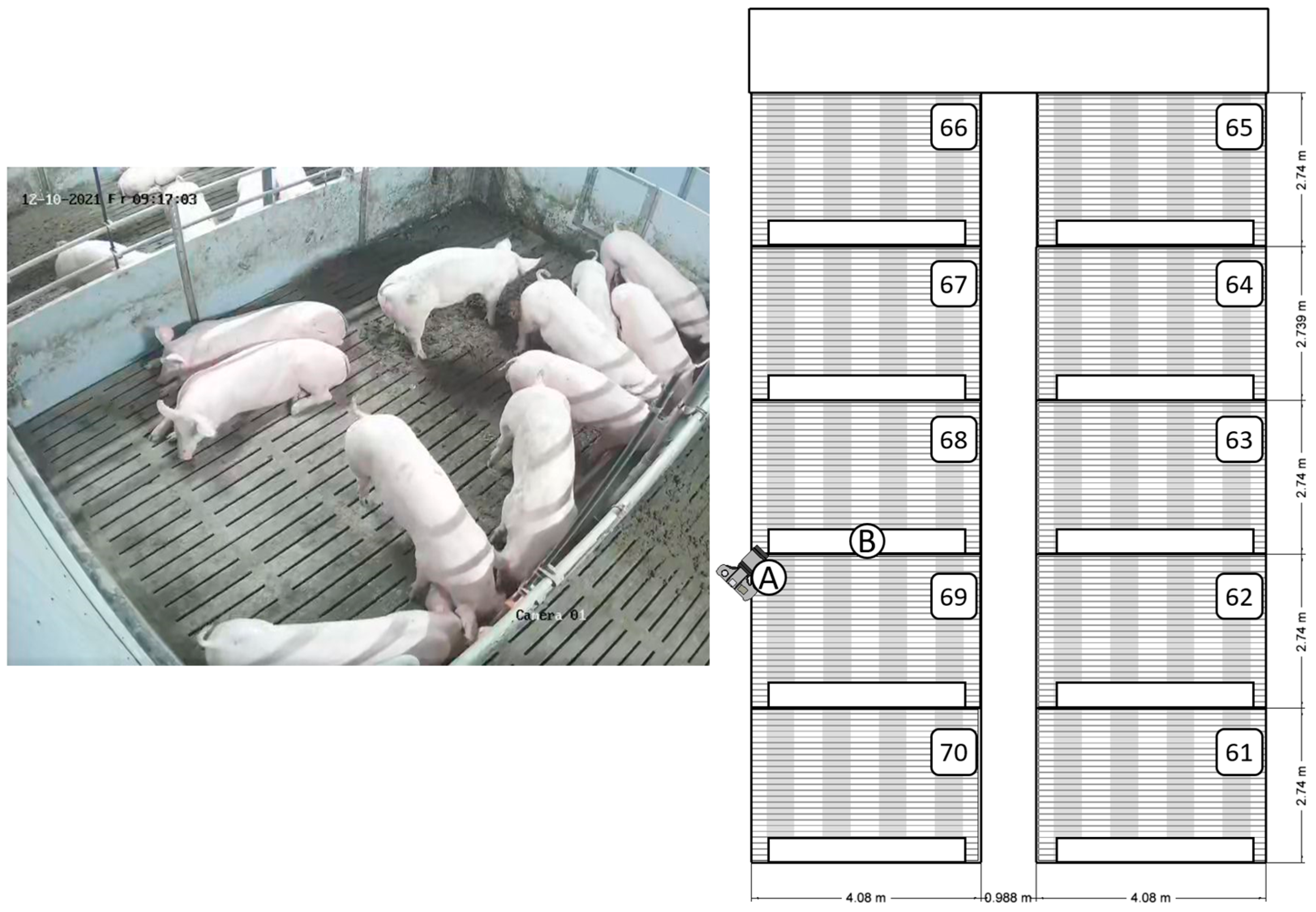

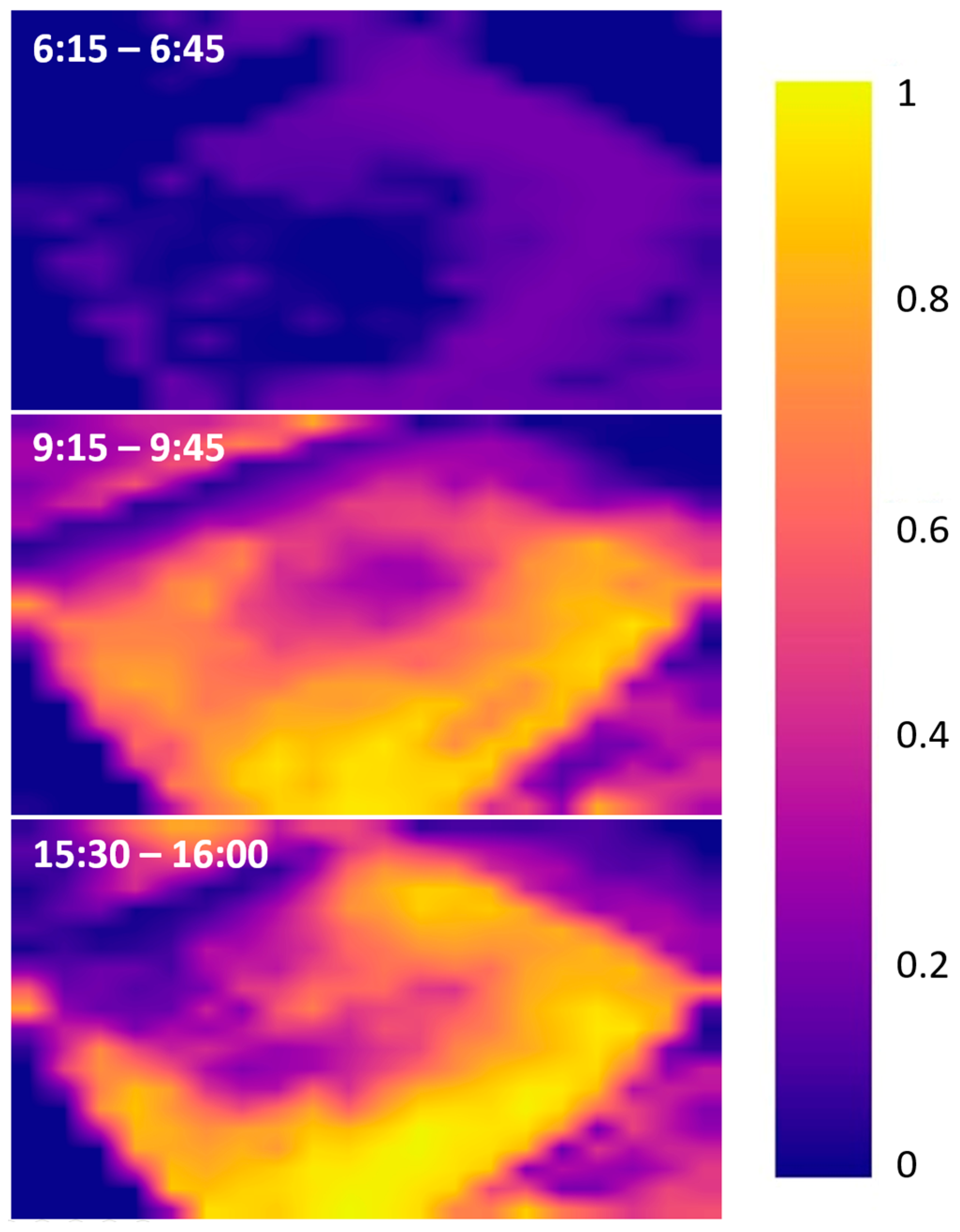
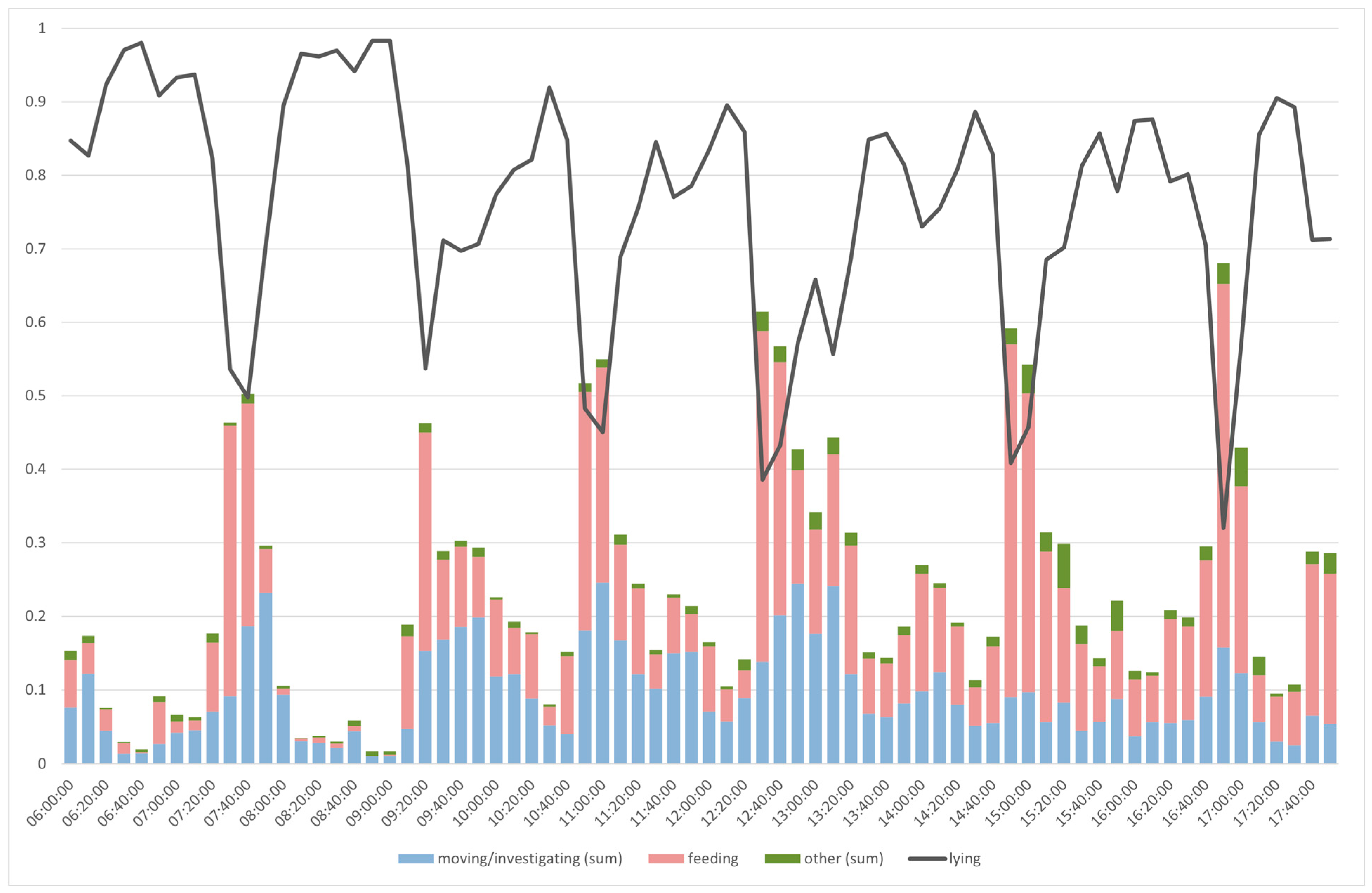

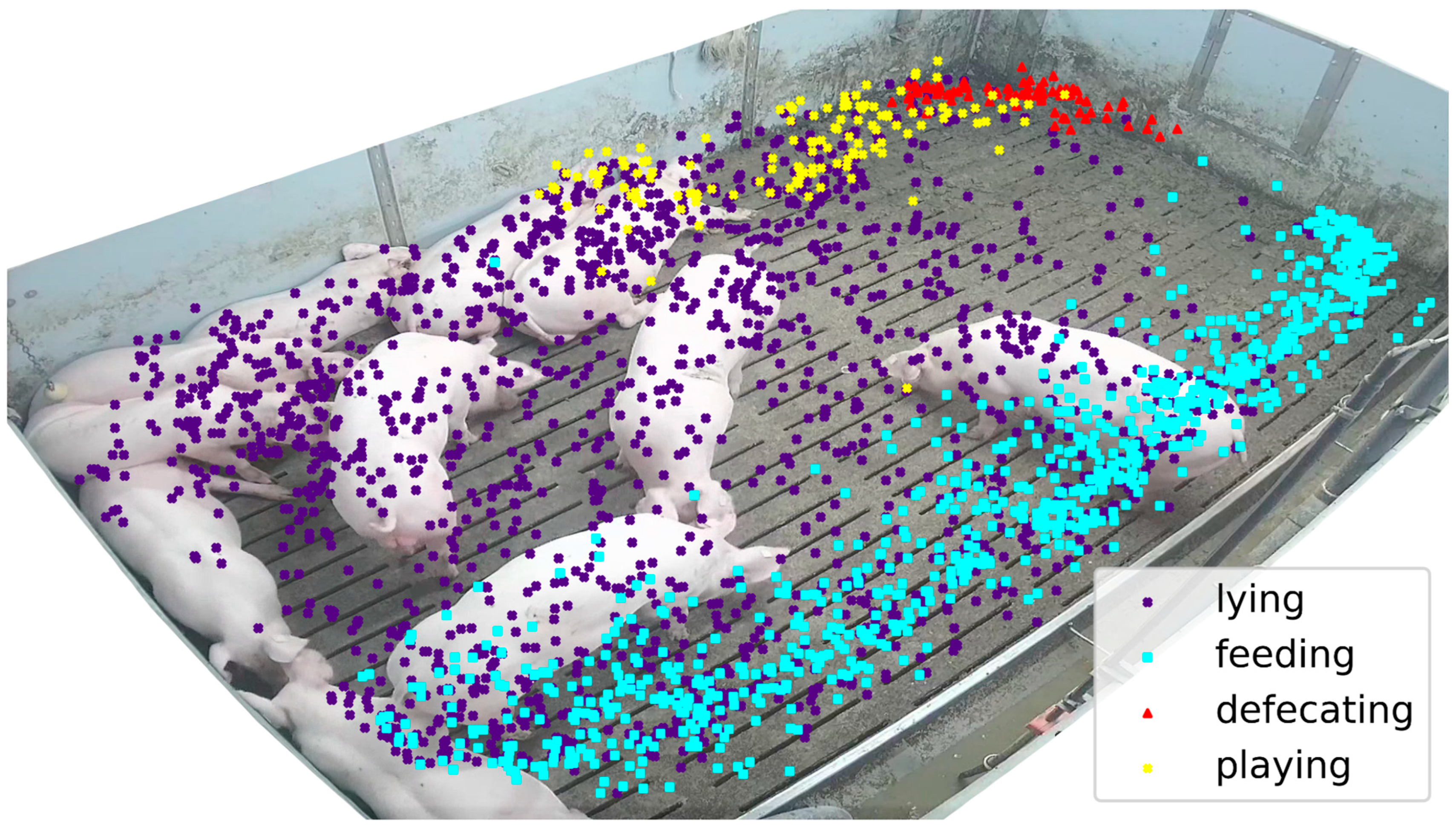
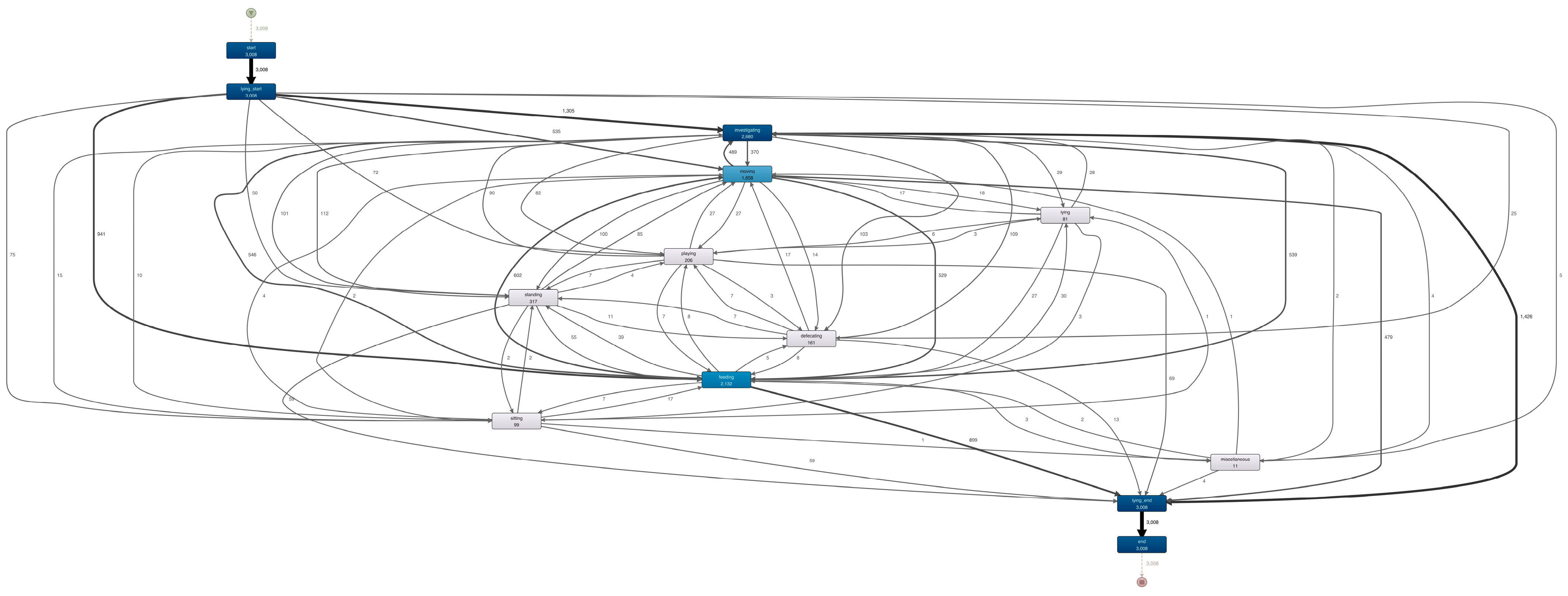
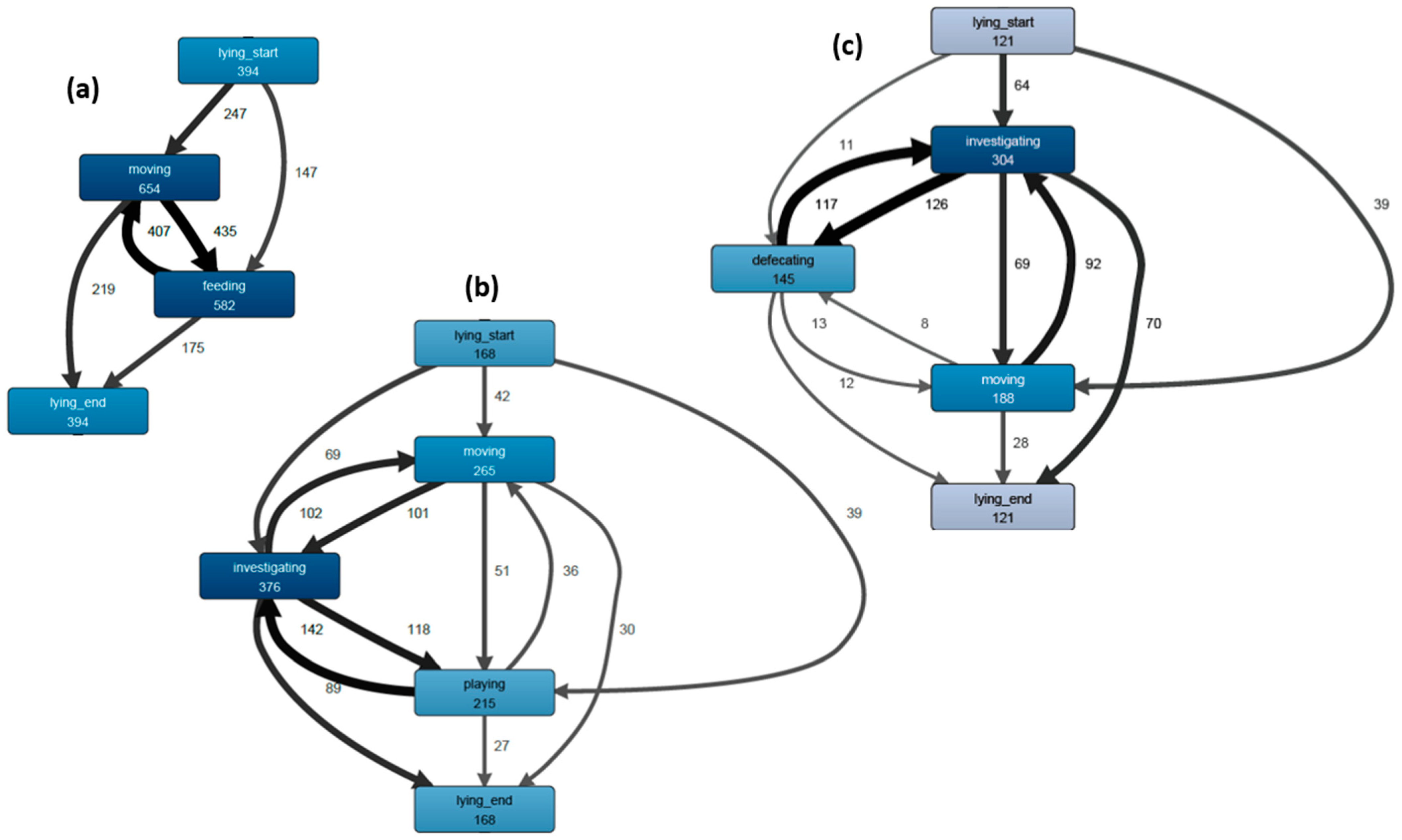
| Behavior | Definition |
|---|---|
| lying | Pig in a resting position, typically lying down on the side of the trunk or chest/sternum, with minimal movement and its body supported by the floor. |
| sitting | Contact to the floor with the feet of the front legs and the posterior portion of the pig’s body. |
| standing | Contact to the floor with all feet without changing position. |
| moving | Pig in motion, displaying walking or running behavior, with all four legs actively moving their body forward. |
| investigating | Pig using its snout to search and dig into the ground or other surfaces, often in a repetitive manner, as part of its natural behavior to find food or explore the surroundings. |
| feeding | Focused engagement with a food source, characterized by repeated chewing, swallowing, and rooting behavior. |
| defecating | Act of elimination, seen as a standing position, followed by the expulsion of feces from the body. |
| playing | Active engagement with occupation material for pigs like ropes. |
| miscellaneous | All other activities that cannot be allocated to any of the above activities. |
| MOTA | IDF1 | # Switches | # Fragmentations | |
|---|---|---|---|---|
| Average | 0.982 | 0.985 | 0.5 | 1.286 |
| Standard Deviation | 0.032 | 0.017 | 0.76 | 1.541 |
| Activity | AP@0.5IoU |
|---|---|
| lying | 0.997 |
| sitting | 0.374 |
| standing | 0.296 |
| moving | 0.807 |
| investigating | 0.793 |
| feeding | 0.994 |
| defecating | 0.960 |
| playing | 0.969 |
| miscellaneous | 0.439 |
| N | Min | Max | Mean | SD | CV (%) | |
|---|---|---|---|---|---|---|
| lying | 360 | 0.094 | 1.000 | 0.766 | 0.233 | 30% |
| sitting | 360 | 0.000 | 0.034 | 0.002 | 0.004 | 229% |
| standing | 360 | 0.000 | 0.068 | 0.004 | 0.007 | 163% |
| moving | 360 | 0.000 | 0.188 | 0.020 | 0.029 | 145% |
| investigating | 360 | 0.000 | 0.577 | 0.074 | 0.107 | 144% |
| feeding | 360 | 0.000 | 0.651 | 0.127 | 0.149 | 118% |
| defecating | 360 | 0.000 | 0.039 | 0.003 | 0.005 | 198% |
| playing | 360 | 0.000 | 0.153 | 0.004 | 0.015 | 346% |
| miscellaneous | 360 | 0.000 | 0.012 | 0.000 | 0.001 | 473% |
Disclaimer/Publisher’s Note: The statements, opinions and data contained in all publications are solely those of the individual author(s) and contributor(s) and not of MDPI and/or the editor(s). MDPI and/or the editor(s) disclaim responsibility for any injury to people or property resulting from any ideas, methods, instructions or products referred to in the content. |
© 2023 by the authors. Licensee MDPI, Basel, Switzerland. This article is an open access article distributed under the terms and conditions of the Creative Commons Attribution (CC BY) license (https://creativecommons.org/licenses/by/4.0/).
Share and Cite
Melfsen, A.; Lepsien, A.; Bosselmann, J.; Koschmider, A.; Hartung, E. Describing Behavior Sequences of Fattening Pigs Using Process Mining on Video Data and Automated Pig Behavior Recognition. Agriculture 2023, 13, 1639. https://doi.org/10.3390/agriculture13081639
Melfsen A, Lepsien A, Bosselmann J, Koschmider A, Hartung E. Describing Behavior Sequences of Fattening Pigs Using Process Mining on Video Data and Automated Pig Behavior Recognition. Agriculture. 2023; 13(8):1639. https://doi.org/10.3390/agriculture13081639
Chicago/Turabian StyleMelfsen, Andreas, Arvid Lepsien, Jan Bosselmann, Agnes Koschmider, and Eberhard Hartung. 2023. "Describing Behavior Sequences of Fattening Pigs Using Process Mining on Video Data and Automated Pig Behavior Recognition" Agriculture 13, no. 8: 1639. https://doi.org/10.3390/agriculture13081639
APA StyleMelfsen, A., Lepsien, A., Bosselmann, J., Koschmider, A., & Hartung, E. (2023). Describing Behavior Sequences of Fattening Pigs Using Process Mining on Video Data and Automated Pig Behavior Recognition. Agriculture, 13(8), 1639. https://doi.org/10.3390/agriculture13081639





